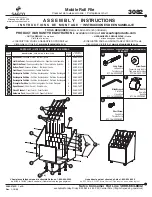
High Performance Oscilloscope Calibrator
Standard Calibration — Basic Sequences
89
Aim of Calibration
The aim of calibrating the Model 9500B Oscilloscope calibrator is to determine the
accuracy of its outputs, and if necessary adjust them so that they are within specification.
If this calibration is to be traceable, then the 9500B's outputs must be compared with
Traceable calibration standards of suitable 'Test Uncertainty Ratio'.
General Calibration Process
As mentioned earlier in section, The Model 9500B Calibration Mode, calibrating each of
the 9500B's functions can be broken down into three distinct stages as follows:
1.
Select the required 'hardware configuration' by selecting the correct 'Cal Range'.
2.
Select 'target' values at which this hardware configuration will be calibrated.
3.
Determine the 9500B's output error at each of these target values, and generate a
suitable compensating correction factor.
This section Standard Calibration — Basic Sequences describes the general process of
calibrating the 9500B using front panel controls.
The following description uses, as an example, the DC/Square function, which has eleven
positive-DC hardware configurations (called 'Cal Ranges') to generate output voltages
b888.00 mV and +222.40 V. Each Cal Range requires two target-value
calibration points, generating two associated correction factors. The factors are stored in
non-volatile memory, and are subsequently used to correct all outputs which employ the
hardware configuration.
We will start by assuming that the 'Cal' mode of the DC Voltage function has been
selected as described in section The Model 9500B Calibration Mode of this manual. This
presents the 'Target Selection' screen, similar to that illustrated in the figure below.
Target Selection Screen — Selecting Hardware Configurations
erw224
















































